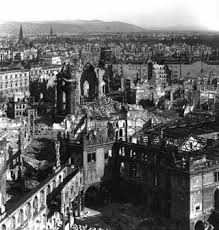Strategic bombing offensive: the science of massed air attacks
 Crudely developed during the later stages of World War II, the SBO was a series of mass attacks from the air on both military and civilian targets. The idea was to destroy your enemy’s capacity to make war on you, and to shatter civilian morale.
Crudely developed during the later stages of World War II, the SBO was a series of mass attacks from the air on both military and civilian targets. The idea was to destroy your enemy’s capacity to make war on you, and to shatter civilian morale.
Before the Second War started there was widespread belief that aircraft would always get through defences and destroy towns and their population. German air attacks on places like Guernica in Republican Spain appeared to confirm this belief, though the propaganda value of Guernica to the Republican government of Spain was priceless, especially when internationally renowned artists like Picasso painted their view of the attack. Sadly, Coventry, Bristol and Desden had no Picassos available to repeat the process when their moment came.
Yet, though this appears strange, neither Britain, Germany, France nor the Soviet Union possessed many heavy bombers in 1939, when the War began. Britain started building the 4-engined Lancaster immediately, but orders were not delivered until 1941.
SBO was first ordered by Hitler against Britain in 1940. In August’s daytime attacks the Luftwaffe lost so many aircraft that they quickly changed to night attacks on London and other large cities in what the English called the Blitz. This went on until May 1941, when Hitler started preparing his air forces for Operation Barbarossa (q.v.) against his erstwhile ally – Soviet Russia. By then around three million homes had been destroyed and more than 60,000 civilians killed in Britain, but Hitler had not planned for the British failure to lower their morale (it actually went up) or halt war production.
Now comes a really bizarre moment: the British air chiefs told the United States that despite the failure of the Bliz they planned to win the War by bombing alone! As the Americans were doubtful at this time whether they would enter the War anyway, this came as a surprise. As we know, Pearl Harbor in December 1941 was enough to make up their mind.
Meanwhile, British bombers were operating at night, as their enemy had done in 1940. The specific targets were arms factories, bridges over rivers, dams in the industrial Ruhr, and massed concentrations of enemy soldiers. But night-flying skills and instruments were inadequate and most of the bombing was atrociously inaccurate, as aerial photography showed.
Then Air Marshal Harris, known as ‘Bomber’, became chief of Bomber Command in 1942, and he promptly went for bigger targets – such as whole cities. He approved of ‘area bombing’ – what the German civilian population knew as ‘terror bombing’. Using the enormous four-engined Avro Lancaster, with a great range and a payload of up to six tons of bombs, he ordered a thousand-bomber raid on Cologne (Köln) in May, 1942, quickly followed by other similar raids on the industrial Ruhr. On 27 July 1943 special incendiary bombs started a fire-storm in Hamburg which is estimated to have killed approximately 50,000 people. Should Britain have lost the War, the first military leader accused of war crimes would have been ‘Bomber’ Harris, a mild man personally. But, the Americans said they disapproved of SBO (though they used it without compunction later); they preferred precision daylight bombing of specific (military) targets, but on 14th October 1943 two-thirds of their aircraft were shot down over Schweinfurt and they suspended bombing until enough fighter escorts could arrive.
The fighter escort they awaited turned out to be the Mustang (operating from December 1943) a fighter superior to anything the Germans could produce. The Mustang ate up the enemy fighter force and made it possible for American daylight bombing to resume in February 1944. The results were so spectacular that when France was invaded on D-Day (6 June, 1944) the Germans could hardly muster a single Messerschmidt to attempt defence.
Meanwhile the Royal Air Force had cut German steel production by 80% in the Ruhr, halving Germany’s overall production. The States continued attacking synthetic oil production plants, but there was a danger of aviation fuel (in Britain, the main base) running out and the bombing fell from 316,000 tons (!) to 17,000 tons in September.
The human loss due to ‘carpet’ bombing was huge, and was later firmly questioned. Between three-quarters of a million and one million German civilians (a conservative estimate surely) were killed in Allied bombing raids. When questioned on this, senior air-force personnel were not very apologetic and asked who had started the War. They frequently added that up till then around 100,000 aircraft crew had also been killed from British and American air bases.
When the US captured Japanese islands in the Pacific they were enabled to begin SBO on the mainland of Japan, reaching a terrible peak in 1945. The idea was to spread terror and this the Americans certainly did in Tokyo on 9 March of this year, when fully a quarter of the city’s mostly wooden buildings went up in flames, taking occupants with them. Between June 1945 and the end of the war fifty-five Japanese cities were attacked, each attack destroying half the built-up area in each town. Finally, when two atomic bombs were dropped on Hiroshima and Nagasaki the strategic bombing offensive ended.










